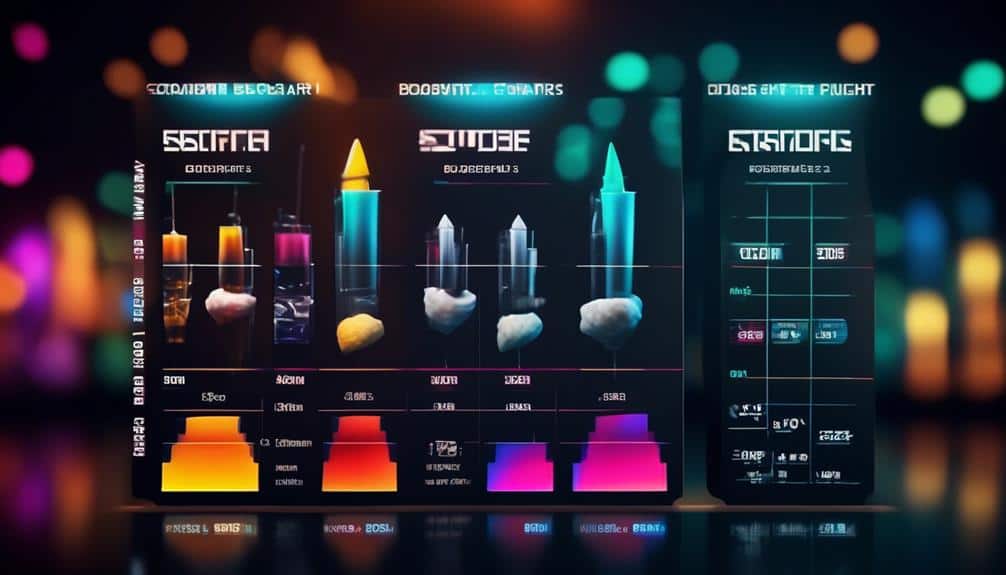Engaging Your Audience: Tips for Making Product Comparisons Captivating
When it comes to comparing products, think of your audience as curious explorers navigating a dense forest of options. As you aim to guide them through this labyrinth of choices, the key lies in not just presenting information but in captivating their attention.
Imagine being able to draw them in, making them eager to uncover the hidden gems that set your products apart. In the realm of product comparisons, the strategies you employ can make all the difference between a mere glance and an in-depth exploration.
So, what are the secrets to crafting comparisons that captivate your audience's interest and drive them towards a decision that benefits them the most?
Key Takeaways
- Utilize interactive visuals to enhance engagement and differentiation
- Craft persuasive and emotionally resonant product descriptions to create urgency
- Develop a strong value proposition by highlighting unique selling points and benefits
- Clearly articulate your product's distinct features and advantages to stand out
Utilize Visual Comparisons

To truly captivate your audience when making product comparisons, incorporating visual aids is essential in conveying the differences effectively. Interactive visuals and engaging graphics can make a world of difference in helping your audience understand the distinctions between products. By utilizing interactive visuals, you can allow your audience to actively engage with the content, making the comparison process more memorable and impactful.
When creating visual comparisons, ensure that the graphics aren't only visually appealing but also informative. Use colors, shapes, and sizes strategically to highlight key differences between the products. Incorporating interactive elements such as sliders, pop-ups, or clickable hotspots can further enhance the user experience and make the comparison more engaging.
Craft Compelling Copy
Crafting compelling copy is essential to capture your audience's attention. You should aim for persuasive product descriptions that highlight the benefits of your offerings.
Make sure to clearly communicate your unique value propositions and differentiation points to stand out in the crowded market.
Persuasive Product Descriptions
Craft captivating product descriptions that entice your audience with compelling storytelling and irresistible details. When crafting your product descriptions, remember that the goal is to not just inform but to also evoke emotions and create a connection with your audience.
Here are some techniques to help you achieve that:
- Paint a vivid picture: Use descriptive language that appeals to the senses, allowing your audience to imagine themselves using the product.
- Evoke emotions: Tap into the power of emotions by highlighting how the product can make your audience feel – whether it's joy, excitement, or nostalgia.
- Create a sense of urgency: Encourage action by emphasizing limited quantities or time-sensitive offers, motivating your audience to make a purchase now.
Strong Value Propositions
Engage your audience effectively by infusing your product descriptions with compelling storytelling and irresistible details, creating a strong value proposition that resonates with potential customers.
Highlighting your unique selling points and competitive advantages is crucial in crafting a value proposition that stands out. Ensure that your effective messaging and brand positioning align with these strengths to convey a clear message to your audience.
By clearly articulating the benefits and advantages of your product or service, you can capture the attention of potential customers and differentiate yourself from competitors. Emphasize what sets you apart and why your offering is the best choice.
Clear Differentiation Points
To captivate your audience and make your product comparisons compelling, focus on articulating clear differentiation points in your copy that highlight what sets your offering apart from competitors. When crafting your copy, emphasize the unique features that make your product stand out and conduct a thorough competitive analysis to understand where your product excels.
Remember, clarity is key in ensuring your audience grasps the distinctions between your product and others. Here's a quick guide to help you effectively convey your product's differentiators:
- Highlight the innovative aspects of your product that address specific customer needs
- Showcase how your product outperforms competitors in key areas
- Illustrate the value your product brings that competitors lack
Crafting compelling copy that clearly communicates these points will help your audience see the unique value your product provides.
Incorporate Customer Testimonials
When it comes to captivating your audience, nothing speaks louder than real-life experiences, personal endorsements, and success stories.
These customer testimonials add authenticity and credibility to your product comparisons, making them more engaging and relatable.
Real-Life Experiences
Inviting customers to share their personal stories about using your products can bring an authentic and compelling dimension to your product comparisons. Customer feedback and personal anecdotes help create a human connection, making your comparisons relatable and trustworthy.
Here's how incorporating real-life experiences can enhance your product comparisons:
- Emotional Connection: Reading about how your product positively impacted someone's life can evoke empathy and resonate with the audience.
- Trust Building: Hearing genuine experiences from customers builds credibility and fosters trust in your brand.
- Inspiration: Real-life stories can inspire others to try your product, knowing it has made a difference in someone else's life.
Personal Endorsements
By incorporating customer testimonials into your product comparisons, you infuse real experiences and authentic feedback that resonate with your audience, enhancing their trust and understanding of your brand. Customer testimonials add a personal touch, showing potential buyers how your products have positively impacted real people. This form of personal endorsement is more relatable than celebrity endorsements or influencer partnerships, as it comes directly from everyday individuals. Here's a comparison to highlight the effectiveness of personal endorsements:
| Personal Endorsements | Celebrity Endorsements |
|---|---|
| Relatable and authentic | Often perceived as less genuine |
| Builds trust with audience | May seem out of touch with reality |
| Reflects real customer experiences | Can be seen as paid promotions |
Incorporating customer testimonials can significantly boost your product comparisons by providing genuine insights that resonate with your audience.
Success Stories
To further enhance the authenticity and trustworthiness in your comparisons, seamlessly integrate success stories through customer testimonials, showcasing the real impact your products have had on individuals. Dive into the world of impact stories and customer insights to truly connect with your audience on a personal level.
Here's how incorporating transformation tales and user feedback can make a difference:
- Joyful Journeys: Witness how our product brought smiles and positivity into the lives of our customers.
- Triumphs of Transformation: Read about the remarkable changes our users experienced after using our products.
- Heartfelt Testimonials: Discover the heartfelt words of gratitude and satisfaction shared by those who've benefited from our offerings.
These real-life stories add a human touch to your comparisons, making them more engaging and relatable.
Highlight Key Differences
Highlighting the key differences between products is like shining a spotlight on their unique features, making it easier for your audience to discern which option best suits their needs.
By using visual examples, you can visually represent the disparities between products, allowing for quick and easy comparison.
Incorporating interactive features into your product comparisons can further engage your audience by enabling them to interact with the content actively. These interactive elements could include sliders to compare specifications side by side or interactive quizzes to help users identify their preferences.
Highlighting key differences not only clarifies the options but also adds an element of excitement to the decision-making process. When presented effectively, these differences can serve as decision-making signposts for your audience, guiding them towards the product that aligns best with their requirements.
Use Infographics and Charts

Shedding light on the key differences between products can be amplified by incorporating visually appealing infographics and charts to make your comparisons more engaging and easily digestible for your audience. Visual appeal plays a crucial role in capturing your audience's attention and ensuring that they stay focused on the content you're presenting.
Here's why using infographics and charts can significantly enhance your product comparisons:
- Enhanced Understanding: Visual representations through infographics and charts help simplify complex information, making it easier for your audience to grasp the differences between products at a glance.
- Increased Engagement: Data visualization not only makes your comparisons more visually appealing but also encourages active participation from your audience as they interact with the content.
- Memorable Impact: Utilizing infographics and charts creates a lasting impression on your audience, ensuring that the key points of your product comparisons are retained long after they've viewed the content.
Implement Interactive Elements
Integrating interactive elements into your product comparisons captivates your audience, fostering a dynamic and immersive experience that enhances understanding and engagement. Interactive quizzes are a fantastic way to involve your audience actively. By incorporating quiz questions related to the products being compared, you can challenge your audience's knowledge while keeping them engaged. It not only educates them about the products but also makes the comparison process enjoyable and memorable.
Polling features can also be incredibly effective in making product comparisons captivating. Encouraging your audience to vote on specific product features or preferences can create a sense of involvement and ownership. It allows them to see how their views align with others and provides valuable insights into consumer preferences.
Frequently Asked Questions
How Can I Effectively Incorporate Storytelling Into My Product Comparisons to Make Them More Engaging?
To make your product comparisons more engaging, weave storytelling with emotions. Paint vivid pictures using visual storytelling to captivate your audience. Connect on a personal level by incorporating relatable narratives that resonate with their experiences.
What Are Some Unique Ways to Showcase Social Proof in Product Comparisons?
To showcase social proof in product comparisons, try incorporating real customer testimonials and reviews. You can also utilize interactive infographics that visually display data, making it easier for your audience to engage with and understand.
How Can I Make My Product Comparisons More Interactive and Engaging for My Audience?
To make your product comparisons more interactive and engaging, try incorporating interactive quizzes and live demonstrations. Utilize customer testimonials and interactive polls to involve your audience in the decision-making process, making it fun and informative.
Are There Any Specific Tools or Software That Can Help Me Create Visually Appealing Infographics for My Product Comparisons?
You can use software tools like Canva or Piktochart for infographic design. They offer templates and easy-to-use interfaces for creating visually appealing infographics. Incorporate visual storytelling and interactive elements to make your product comparisons captivating.
What Strategies Can I Use to Keep My Audience's Attention and Interest Throughout a Lengthy Product Comparison?
To keep your audience engaged during a product comparison, use captivating storytelling techniques and incorporate visual aids. These strategies will help retain their interest and attention throughout the comparison, making the information more digestible and memorable.
Conclusion
Now that you have learned these tips for making product comparisons captivating, you're ready to engage your audience like never before.
By utilizing visual comparisons, crafting compelling copy, incorporating customer testimonials, highlighting key differences, and using infographics and charts, you can create an interactive and informative experience for your customers.
Keep these strategies in mind as you showcase your products and watch as your audience becomes more engaged and interested in what you have to offer.








